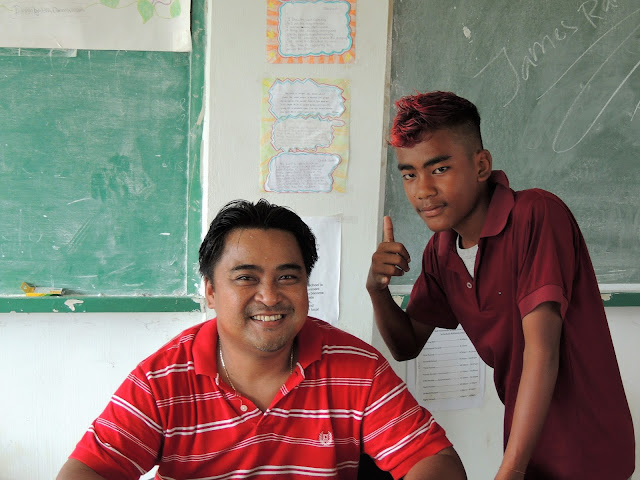After
holding down the fort in Rainbow Lake for a few months, I have joined Roger in Pohnpei. It was hard to leave family, friends, and
Digger, but I know they will all do just fine without me. Being apart for three and a half months….that
I would not recommend. Together is
better!
I
was greeted on my arrival by Roger and Bernie (a Peace Corps Response staff
person). I got a big hug and kiss from
Roger and a mwaramwar (local native headdress made from flowers and leaves)
from Bernie. Since I came two weeks
early, there were no other Response Volunteers arriving with me. A new group will arrive here on August 2, and
I will join them for our five days of “training.” I spent the rest of my first week meeting
Peace Corps Response Volunteers and PC Staff.
The PCVRs are working with the new two-year recruits, helping them to
prepare for their teaching assignment by sitting in on Model School classes
taught by the recruits and their Pohnpeian cooperating teachers. The recruits seem young (because they are)
and enthusiastic (because they are young), and it was fun watching them
interact with the teachers and students in the classroom. There will be much more to tell about my work
here, once I really get started and know exactly what I will be doing.
Aside
from meeting new people and anticipating what my work will be, the most amazing
part of my first days here is the environment—vegetation on steroids, heat,
humidity, and rain. This is a tropical
island in all respects. It is
hot, but I am trying not to complain too much….I just mop the sweat off my brow
and continue along. The vegetation,
especially the flowers and other plants/trees are other-worldly, and I am
looking forward to learning as much as I can about them. I have already sent to Amazon for a tropical
plant identification book. There will be
more about this as time goes on.
The
other totally new experience is the food.
Roger’s diet of Pringles, Rice-a-Roni, and Oreo cookies was a non-starter
for me. The first day here we went to Simon’s Market and saw the most amazing display
of bananas, pineapple, papaya, coconut, and more. The bananas are the most impressive (see the
pictures below). We talked with the young
man working there to find out about different varieties. Some are for eating, some are for cooking (I can
attest that I am not yet a fan of the cooking bananas….I tried one for lunch at
the PC training site—dense, starchy, hard, and tasteless). At the market there were probably a dozen
varieties for sale, and I understand that there are more than thirty grown on
the island. Our favorite so far is a
small eating banana that has a sweet flavor and does not get soft and mushy
(yuck!) like the ones at home. Yesterday
we returned to the market and bought several other varieties we are anxious to
try.
Equally
appealing at the market was a room filled with coolers of fish. The catch-of-the-day determines what is for
sale. Yesterday there was blue parrot fish, tuna, red snapper and more. We decided on the snapper and the fishmonger
filleted it for us….the two and a half pound whole fish netted two very nice
fillets. We had already bought a small
charcoal grill so our dinner was the grilled snapper (with a delicious spice
rub), local pineapple, local cucumber, and rice. How can you beat that!
So,
first impressions have been positive.
Stay tuned for more to come.






















































